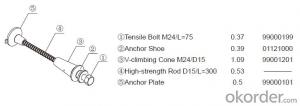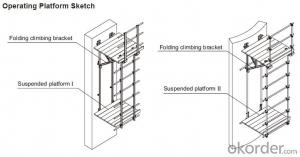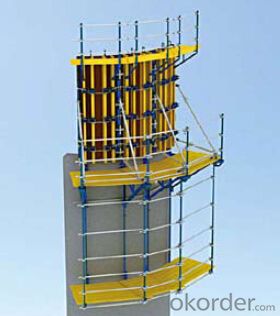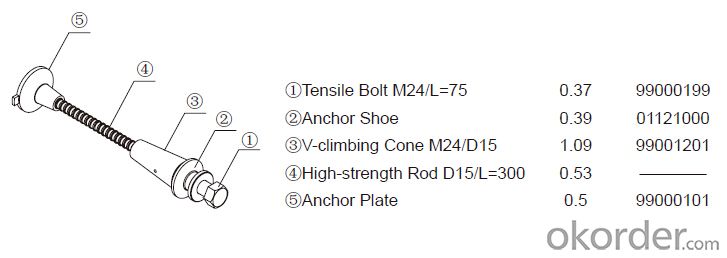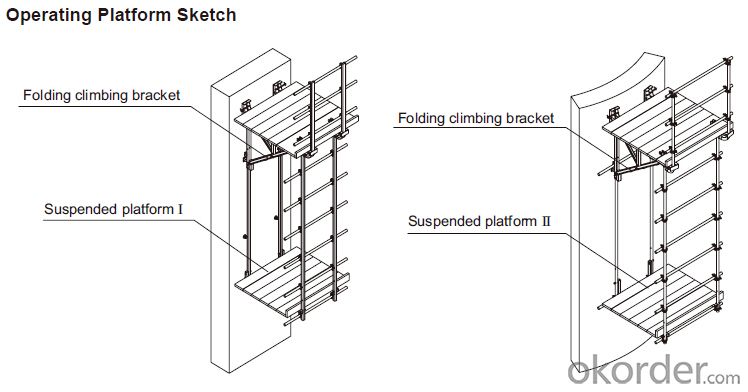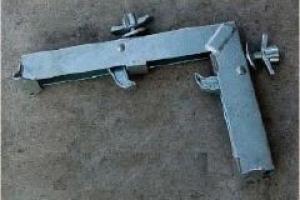Climbing-Platform CP-190 for formwork and scaffolding systems
- Loading Port:
- Tianjin
- Payment Terms:
- TT OR LC
- Min Order Qty:
- 50 m²
- Supply Capability:
- 1000 m²/month
OKorder Service Pledge
OKorder Financial Service
You Might Also Like
Climbing Platform CP190
Climbing bracket CP190 is mainly used as operating platform during construction. It can be used
on the vertical wall and arced wall. The bracket hang on the anchor system and all the load are
supported by anchor system. It’s convenient to assemble and dismantle, the construction is easy,
rapid and safe.
Anchor System:
Anchor system is the most important supporting part. The system is made of five parts shown
below. There into, tensile bolt, anchor shoe and V-climbing cone can be taken out for reusing.
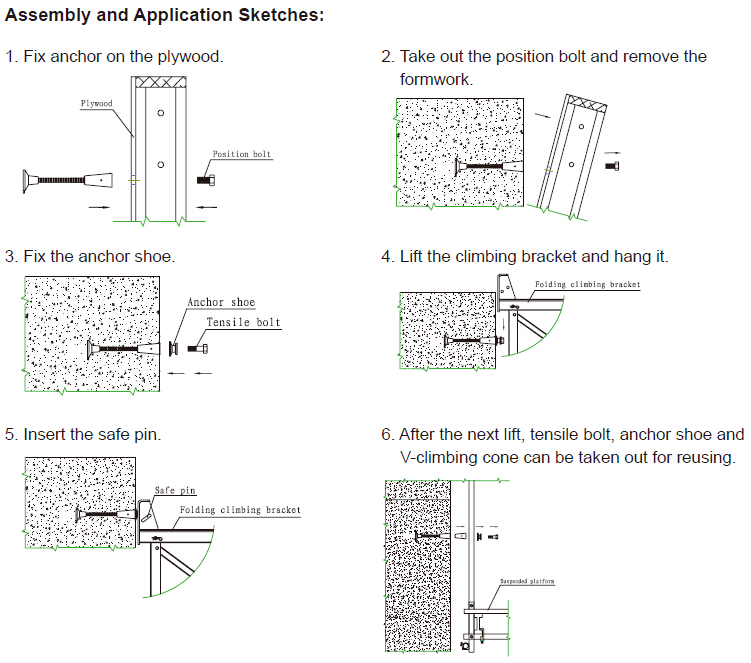
- Q: Is steel formwork more expensive than other types of formwork?
- Yes, steel formwork is generally more expensive than other types of formwork. Steel is a durable and strong material, making it a preferred choice for construction projects. However, its higher cost compared to alternatives such as wood or plastic formwork can be attributed to the higher manufacturing and material costs associated with steel.
- Q: What are the different edge protection systems available for steel formwork?
- Some of the different edge protection systems available for steel formwork include edge protectors, guardrails, safety nets, and toe boards.
- Q: What are the different types of formwork clamps used in steel formwork?
- In steel formwork construction, various types of formwork clamps are commonly utilized. Their purpose is to ensure the firm connection of formwork panels, thereby guaranteeing stability and accuracy during the concrete pouring process. 1. Wedge Clamps: Among the most frequently employed formwork clamps are wedge clamps. These clamps consist of wedge-shaped pieces that are inserted into slots on the formwork panels. As the wedges are driven further into the slots, a tight and secure connection is established between the panels. 2. Rapid Clamps: Rapid clamps are designed for swift and effortless installation and removal. Equipped with a spring-loaded mechanism, these clamps enable easy tightening or loosening with minimal exertion. 3. Turnbuckle Clamps: Adjustable clamps known as turnbuckle clamps provide additional tension and support to the formwork panels. Comprising a threaded rod with a turnbuckle mechanism, these clamps can be tightened or loosened to adjust the tension on the formwork. 4. Pipe Clamps: Pipe clamps employ pipes or tubes to connect and secure the formwork panels. Typically, they consist of U-shaped brackets attached to the formwork panels and pipes or tubes inserted into the brackets to hold the panels together. 5. Panel Clamps: Panel clamps are specially designed to hold large formwork panels together. These clamps usually feature a large, heavy-duty mechanism that can be tightened or loosened to securely hold the panels in place. Each type of formwork clamp possesses its own unique characteristics and advantages. The selection of the appropriate clamp depends on factors such as the size and weight of the formwork panels, the desired level of stability, and the specific requirements of the construction project.
- Q: What are the common quality control measures for steel formwork?
- Steel formwork undergoes several quality control measures to ensure its compliance with standards and specifications: 1. Thoroughly inspect the steel formwork for visible defects or damage, such as cracks, dents, or deformations, and address them accordingly. 2. Measure the dimensions of the steel formwork, including length, width, and height, and compare them to the specified requirements. Correct any deviations from the required dimensions. 3. Conduct material testing to verify that the steel formwork meets the necessary standards and specifications. This includes testing its tensile strength, yield strength, hardness, and chemical composition. 4. Inspect the quality of welds if the steel formwork is welded. Check for proper penetration, fusion, and the absence of defects like cracks or porosity. Employ non-destructive testing methods like ultrasonic or radiographic testing to ensure the integrity of the welds. 5. Inspect the surface coating, such as paint or galvanized coating, for thickness, adhesion, and uniformity. This guarantees protection against corrosion and enhances the durability of the formwork. 6. Subject the steel formwork to load testing to evaluate its structural integrity and load-bearing capacity. Apply a known load and monitor the formwork's response to ensure it can safely support the required loads during construction. 7. Document and maintain records of the quality control measures for future reference. This includes recording inspection results, material test reports, and any corrective actions taken. By implementing these quality control measures, the steel formwork can meet the necessary standards, specifications, and safety regulations, ensuring its structural integrity and performance during construction.
- Q: Can steel formwork be used in areas with limited construction space or tight site constraints?
- Yes, steel formwork can be used in areas with limited construction space or tight site constraints. Steel formwork systems are highly versatile and can be customized to fit into small or irregularly shaped spaces. They can be easily adjusted and modified to accommodate different project requirements and site constraints. Additionally, steel formwork offers high strength and durability, allowing for efficient construction even in challenging site conditions.
- Q: How does steel formwork handle different concrete durability requirements?
- Steel formwork is a versatile and durable solution that can effectively handle different concrete durability requirements. The strength and rigidity of steel make it ideal for withstanding the pressures and stresses exerted by the concrete being poured. Steel formwork is highly adaptable and can be customized to meet specific durability requirements. This allows for the creation of formwork systems that are capable of withstanding harsh environmental conditions, such as extreme temperatures, moisture, and chemical exposure. Additionally, steel formwork can be designed to accommodate various load-bearing requirements, ensuring that the structure remains stable and secure during and after the concrete casting process. Moreover, steel formwork offers excellent dimensional stability, which is essential for achieving accurate and precise concrete finishes. This is particularly important when constructing structures that require a high level of aesthetic appeal or when intricate architectural designs are involved. Another advantage of steel formwork is its reusability. Unlike other types of formwork, steel can be used multiple times, minimizing waste and reducing overall construction costs. This makes it a cost-effective solution for projects with varying concrete durability requirements, as the formwork can be easily adjusted and reused for different applications. In summary, steel formwork is a reliable and adaptable solution that can effectively handle different concrete durability requirements. Its strength, customizability, dimensional stability, and reusability make it an ideal choice for a wide range of construction projects, ensuring that the concrete structures meet the desired durability standards.
- Q: How does steel formwork handle high concrete pressures?
- The exceptional strength and durability of steel formwork make it highly adept at handling high concrete pressures. When faced with significant pressure, steel formwork maintains its shape and structure, serving as a stable and dependable framework for the poured concrete. The strength of steel formwork lies in its capacity to withstand the immense forces generated by the weight and fluidity of the concrete. Steel possesses inherent strength and a high load-bearing ability, enabling it to resist the pressure exerted by the concrete during the pouring and curing process. Furthermore, steel formwork incorporates reinforcement and bracing systems that further enhance its capability to withstand high concrete pressures. Reinforcements, such as steel bars or mesh, are strategically positioned within the formwork structure to provide additional support and prevent any deformation or failure. These reinforcements evenly distribute stress across the formwork, minimizing the risk of damage caused by excessive pressure. Additionally, steel formwork is commonly designed with robust connection points and interlocking mechanisms. These features ensure that the individual components of the formwork system remain securely connected, preventing any collapse or failure under high concrete pressures. The interlocking nature of steel formwork also helps maintain the integrity of the structure and prevents any leakage or seepage of the concrete. In conclusion, steel formwork is specifically engineered to effectively handle high concrete pressures. The intrinsic strength of steel, combined with reinforcement and bracing systems, guarantees that the formwork can withstand the enormous forces exerted by the weight and fluidity of the concrete. Its ability to retain its shape and stability under pressure establishes steel formwork as a reliable and widely chosen option for construction projects that require high concrete pressures.
- Q: What are the different types of release agents used with steel formwork?
- There exist various release agents that can be utilized with steel formwork. Some of the most frequently encountered types encompass: 1. Water-based release agents: These release agents consist mainly of water, with additives like surfactants and lubricants. They are environmentally friendly and can be easily applied by spraying or brushing onto the steel formwork. By forming a thin film on the steel surface, water-based release agents prevent the concrete from adhering during the curing process. 2. Solvent-based release agents: Organic solvents serve as the carrier for the active ingredients in these release agents. They are effective in providing a smooth surface finish on the concrete and are often employed in situations where a higher level of release performance is required. Application is typically done through spraying or brushing, and the solvents evaporate quickly, leaving a thin film on the steel formwork. 3. Barrier release agents: These release agents are usually applied as a thick paste or gel, creating a physical barrier between the steel formwork and the concrete. They are commonly used when a high-quality surface finish is desired, such as in architectural concrete applications. Brushing or troweling the barrier release agents onto the steel formwork is the typical method of application. 4. Dry release agents: These agents come in powdered or granular form and are directly applied to the steel formwork. They create a non-stick surface by absorbing excess moisture from the concrete, thus preventing adhesion. Dry release agents are often employed in situations where other types of release agents may not be suitable, such as in cold weather conditions. 5. Form release oils: Petroleum-based products, known as form release oils, are frequently used in conjunction with steel formwork. They effectively establish a release barrier between the steel and the concrete, preventing adhesion. Application of form release oils is typically done through spraying or brushing, and they can be utilized in various concrete applications. The selection of the appropriate release agent is crucial and should be based on specific project requirements, including the desired surface finish, environmental considerations, and ease of application. Seeking guidance from professionals or consulting the manufacturer's recommendations can aid in determining the most suitable release agent for a particular steel formwork application.
- Q: Can steel formwork be used for industrial flooring?
- Indeed, industrial flooring can be constructed using steel formwork. Renowned for its robustness and resilience, steel formwork proves to be well-suited for demanding tasks, particularly in heavy-duty applications like industrial flooring. It possesses the ability to withstand the substantial weight and pressure imposed by heavy machinery and equipment, presenting a reliable and firm foundation for industrial operations. Moreover, steel formwork boasts the added benefit of reusability, rendering it a financially prudent option for industrial flooring.
- Q: Can steel formwork be used for both flat and sloped concrete surfaces?
- Yes, steel formwork can be used for both flat and sloped concrete surfaces. Steel formwork is highly versatile and can be easily adjusted and shaped to accommodate different angles and slopes during the concrete pouring process. Its strength and rigidity make it suitable for supporting the weight and pressure of the concrete, ensuring a smooth and uniform finish regardless of the surface inclination.
Send your message to us
Climbing-Platform CP-190 for formwork and scaffolding systems
- Loading Port:
- Tianjin
- Payment Terms:
- TT OR LC
- Min Order Qty:
- 50 m²
- Supply Capability:
- 1000 m²/month
OKorder Service Pledge
OKorder Financial Service
Similar products
Hot products
Hot Searches
Related keywords

